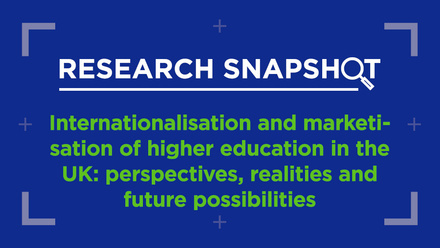How to personalise your digital higher education marketing

Personal communication is still the best approach when it comes to higher education marketing. The trick in this digital age is to see how a personal approach can be used to achieve marketing goals.
Academic staff know exactly which students will be the best match for their programme. This fact and the related data enable us to deploy the services of marketers for marketing purposes in an even more efficient way. We need to work like a recruitment agency – each vacancy has a specific job profile. And an employer knows exactly who they are looking for, so they will search with a specific focus. So that's our approach: targeted online recruiting of prospective students.
Students feel honoured
Targeted online recruiting of prospective students with a high probability of admission is a very effective way to personalise the digital student journey. By carefully selecting and personally inviting students via LinkedIn, the programme can start a direct dialogue with applicants who have the right academic qualifications, interests and motivation. Students will feel honoured to be selected and invited to join the programme. They are keen to learn more about the programme, can raise any personal questions or concerns directly to programme staff and will be willing to share their personal information in order to determine whether they fit the programme.
Instead of waiting passively for interested (admissible and non-admissible) students to apply, the programme proactively sends a LinkedIn invitation to those students who have a high chance of being admitted. As soon as the student accepts the contact invitation, the programme can enter into a one-on-one dialogue with the student and/or post and share relevant content and details about the programme.
Relevant for the student
Students are very open and positive about being approached via LinkedIn as long as it is relevant to them personally. A structured search and selection procedure, based on motivational and academic data, is therefore an absolute prerequisite. It makes sense for the student to be approached if he or she is considering a master’s programme abroad and in that specific field of interest.
Relevant for the programme
By thinking and selecting up front who to invite for the programme, the programme gets more control over who will apply, ie the ideal mix in the classroom. If, for example, it is important for quality in the classroom to have different cultural perspectives and opinions, then the focus of the social recruitment should reflect this. If it is important that applicants have some relevant work experience, the programme recruiter should focus on graduates with work experience.
High efficiency through targeted effort
Social recruitment calls for attention and dedication. Time and a great deal of effort are needed to search for and invite the right contacts, to maintain relationships, answer and follow up on questions in a personal and timely manner. And it requires time to create relevant content to inspire and hold the attention of the pool of talented prospects. Holding their attention therefore also requires content planning. In this way, you can really generate PR for your programme.
Social recruitment, however, is highly effective in targeting the right students and supporting them through the different steps of awareness, interest, application, admission and enrolment. Precious time and effort will be saved in the application and admission process as most of the students applying will already have been “pre-screened” in relation to likelihood of admission.
Start small, think big, act smartly
In order to determine the feasibility for your programme, we recommend you set up a small pilot with one or two programmes. This limits the risks, cost and impact on resources and allows for fast learning. The pilot should be set up in such a way that it is potentially applicable for all programmes. If successful, it can then be rolled out quickly for other programmes. Furthermore, it is important that the pilot should not interfere with the regular ‘funnel’ activities. Finally, make sure that you measure the effectiveness of this approach and compare it with your regular activities.
The six steps to get you on your way:
- Intake with the programme
- Match the search profile with programme requirements
- Create texts for all invitation communication (invitation, in-depth contact, remarketing, etc)
- Make a selection from LinkedIn
- Check the list thoroughly!
- Higher education marketer at the institution has to make the first contact from a LinkedIn company account
We encourage you to follow these steps to start taking advantage of all your personalised marketing activities have to offer!






